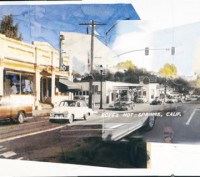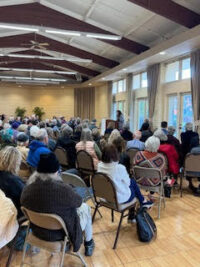By Fred Allebach — As eligibility and demand for affordable housing grows, and workers making the County’s median income are priced out of the market, the City of Sonoma of initiates a process to deal with the growing problem.
Along with the cities of Sonoma County in general, the City of Sonoma suffers from a lack of affordable housing. The loss of redevelopment agency funding for affordable housing in 2012 reduced the city’s ability to offer subsidies or land purchases to affordable housing developers, and as a result it has relied solely upon its “inclusionary” requirement to fulfill a portion of its affordable housing needs.
Most everyone agrees that the inclusionary requirement alone, which mandates that affordable units be included in housing developments of five units or larger, cannot satisfy demand. Lack of affordable housing is the major reason that only sixteen percent of people who work in Sonoma live in Sonoma
Affordable housing is defined in law; to qualify, such housing is tied to various income levels from extremely low to moderate. Accordingly, it applies to a broad cross-section of population, ranging from teachers and firefighters to housekeepers and disabled veterans.
Defining income and affordability levels
Current inclusionary requirement policy calls for 20 percent of units over a threshold of five developed units total must be affordable, and this affordability level is defined as appropriate for “moderate income” households, or 120 percent of the Area Median Income (AMI).
(For a detailed explanation, see: http://www.sonoma-county.org/cdc/cd_ah_income_limits.htm)
Terms used such as “workforce housing” and “affordable housing” are sometimes interchangeably. A covert value judgment often seems to be in operation: if a speaker says “workforce housing,” he or she seems to imply that the “workforce” is made up of people who are worthy, whereas affordable housing might signify people who don’t work and who need financial subsidies. But because anyone from extremely low to moderate income qualifies for affordable housing, the terms have virtually the same meaning.
AMI is measured on a percent basis relative to 100 percent of the median income. Extremely low income is below 50 percent of AMI, very low is 50 percent of AMI, low is 80 percent of AMI, and moderate is 120 percent of AMI. The bulk of county population is in the 120 percent AMI and below category.
What is the AMI in money terms? The 2016 county median income goes from a single individual earning $57,800 to a household of eight earning $109,070.
These numbers are at the heart of our housing crisis. Given the average regional rental housing cost of $1,600 per month and average home sale price of near $600,000, it is reasonable to conclude that no housing options are affordable to anyone in the above AMI range. Affordable housing in Sonoma and Sonoma County will be needed by anyone earning annual income on both sides of the median income.
Working full time at minimum wage generates $19,500 a year; working full time at $15/hour generates $28,000 a year. The predominant county hospitality and tourism industry pays this level of wages. But where can those workers afford to live?
Surveying the problem
Some months ago, the Sonoma commissioned a study regarding the potential to impose an “impact fee” on developers in addition to, or instead of, the inclusionary requirement. The study was presented a joint session of the City Council and the Planning Commission on August 15.
Many ideas were presented to generate funding for affordable housing. The primary topic revolved around modifying inclusionary requirements on otherwise market-rate housing developments. Housing impact fees and in lieu fees (fees paid to avoid the requirement) were discussed for market rate housing projects and also in relation to commercial development.
At the recent meeting, the consultants reviewed what other cities and the unincorporated county were doing and then asked the City Council members and Planning Commissioners for feedback on whether, in Sonoma, on-site inclusions were better than assessing fees.
Planning Commission Chair Robert Felder said that Sonoma tends to have smaller projects and thus on-site inclusions of affordable housing (AH) might make more sense. He noted there are not many housing opportunity sites left. Felder also expressed a preference, and incentives, for more lower-end housing units.
Commissioner Bill Willers asked for a planning remedy; at present commercial developments have two options, include housing or obtain a waiver of the housing requirement and build a 100 percent commercial project. Willers, in effect, called for imposing housing impact fees on commercial development, thereby replacing the waiver.
City Councilmembers Rachel Hundley and Gary Edwards explored the idea of fees and how much revenue they might generate. Edwards suggested that high fees, like “$100,000 a head,” could be required. He noted that it is difficult to put AH in a luxury development. Council member David Cook asked that “over-housing” be explored as a potential for gaining housing stock. He said 67 percent of people in CA were over-housed, i.e. had more living space than they needed.
Mayor Laurie Gallian said “business as usual” was not working. She noted that 571 units was the future housing unit “build-out potential,” and she wondered what in the current affordable housing inventory was protected by remaining covenants and easements.
Chair Felder finished the first round of discussion by saying that AH waivers should have a consequence: “either you build AH or pay a fee.”
Sonoma Mayor Gallian noted an “astounding figure of how many who work here who can’t afford to live here.” Councilmember Hundley noted that AH would be more efficiently built in bigger projects. She suggested that use fees from large, market-rate and commercial projects could pay for concentrated AH developments.
Cook advocated “outside the box” thinking, such as Lilypad tiny homes, and partnering with the County. Councilmember Edwards called for junior units, shared housing, making the Oregon Street units two-story and for no new vacation rentals. He cautioned if there were too many restrictions, developers would not build.
Willers said that low and very low income housing is impossible without government subsidies, and that with for-profit developers, the use of public money brings certain requirements, the same ones Edwards noted as possible “deal breakers.”
Willers said the development code provides no guidance over the size and scale of units. Currently, he feels, the inclusionary requirement simply drives up the price of the associated market rate units. He noted that smaller units simply cost less, and that the City could incentivize developers to include smaller units in their plan.
Commissioner Robert McDonald suggested the City look at lot size and zoning, and try and accommodate income targets that way. Focus on larger lots such as the Safeway parcel, he suggested, and require more stringent income diversity. He suggested that fee money could be given directly to households, like Section 8 vouchers.
Commissioner James Cribb said the solution is best found in zoning rules rather than fees and thresholds. “If we drop unit sizes and income thresholds lower, it disincentives builders too much,” he said.
Chair Felder said the City should direct the type of projects it would allow, and not just allow the building of mega mansions. Edwards said the Planning Department could make a deal with the mega-mansion builders for hundreds of thousands of dollars in fees.
Mayor Gallian noted rental units are in demand, too, and that “we should look at our needs — AH for individuals, seniors and young.”
Developer incentives
Various types of incentives were reviewed: Fee waivers/deferrals, fast-track priority, design flexibility, smaller size/less interior finish, AH units built in the County, and state density bonus law.
Edwards said, “identify land and give developers the menu. ‘This is what we need, make an offer.’” He suggested the City design an offer attractive to developers so that they “have an idea of what we really want.”
Mayor Gallian inquired about a housing trust, an option being used by other municipalities.
Willers said, “the market takes the easiest path, like water.” If the City’s priorities are well defined, he added, it will get what it wants. Willers advocated different levels of housing overall and noted that condos always cost less than homes. Different levels of housing would break the market into income-oriented housing segments. He would like to see less subdividing of parcels, as larger parcels clearly requires apartments and rental units.
Commissioner McDonald suggested an ordinance that regulates maximum unit size. He inquired whether fees would apply when, for example, if use changes form an office to a hotel.
A segment of the discussion focused on deed restrictions, AH in certain geographic areas, creating second units, and small additions.
Sonoma City Planning Director David Goodison noted various approaches underway: a junior second unit ordinance, identifying over-housed units and matching them with a potential roommate, and possible additional regulation of vacation rentals in mixed use zoning areas again. As for a housing trust fund, he noted that Sonoma Land Trust is interested in partnering with Sonoma on housing, which is part of the ABAG holistic approach to affordable housing.
Public comment
As a member of the public, Chris Petlock said that workforce housing is AH, and that we should keep workers close by, which would produce fewer GHG emissions. Larry Barnett suggested raising the city’s TOT by 2 percent, which would produce a minimum of $750,000 a year, and imposing a moratorium on development until the in-lieu fee structure is in effect. Meanwhile, the city could buy the land targeted for AH.
Julie Leitzell wants to retain the small town character she moved here to get, and “not put out a red carpet for higher density.” She said that this is a very expensive, very nice area and to keep the zoning as is. She added that AH does not fit current town style; if people want to live here, they can get up early in the morning and save the money like she did.
Going forward
The City’s consulting firm will next conduct a Nexus Study, linking the community’s needs for affordable housing to its population and commercial growth to determine the legitimacy of impact fees, and what the range of such fees might possibly be.
The Nexus Study is based upon the following premise: new market rate and commercial developments bring new residents and new demands for goods and services; this creates demand for workers, some of whom are lower-paid. These lower income workers need housing, so there is more demand for low income housing. The cost of building AH in the City for additional lower-paid workers is then supported by various fees and assessments.
The next question is, can market rate developers even enter into the discussion for building such housing? Is covenanted AH only possible to build by nonprofit housing developers such as MidPen, the firm building the AH complex in the Springs?
There seems to be a general acknowledgment that the housing needs of low and very low (60, 80 and even 120 percent of AMI) will only be served by AH built by nonprofit housing developers.
What is clear is that government and the public is engaged on the topic of providing affordable housing. The August meeting appeared to demonstrate the resolve of elected officials, commissioners, city staff and the public. Over 30 members of the public attended, including Supervisor Susan Gorin.
Clearly, the consensus is that there is a serious housing problem, if not crisis, as housing costs continue to outpace the County’s median income range.














This is about repeated colonization since the 80s there is a colonization movement from the south. Here they come with the profits from selling that San Jo or SF home, their bay area incomes and they just buy up every thing in sight. Because they CAN.
And then, the Julie Leitzells move in…colonizers on steroids….wanting to limit affordable housing so that her ever so special dollars are not diminished. After all, she is here now and only elites like her are able to lend to the rural character of an area that was populated by large numbers of multi-generational natives only 20 years ago.
More market rate housing is an insult and there is a glut of bay or southers here owning it. More of that housing will only bring more commuters and further the elitest commuter and second home haven my home has become.
Enough, Julie. We did work and save. Bigot.